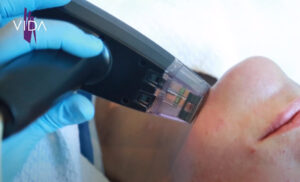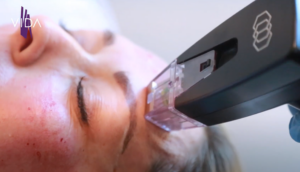What Is Microneedling? Everything You Need to Know About This Revolutionary Skin Rejuvenation Treatment
What Is Microneedling?
Microneedling is a cosmetic procedure that involves using a device with fine needles to create tiny punctures in the skin. The treatment enhances the skin’s look by decreasing the appearance of scars, fine lines, and wrinkles and improving the skin’s overall texture and tone.
A specialist will use a device with tiny needles during a microneedling procedure to penetrate the skin in microscopic amounts. The needles are typically between 0.5 and 2.5 millimeters long and contain titanium or stainless steel. The device makes an evenly spaced-apart pattern of punctures on the skin by rolling it over.
How Does Microneedling Work?
Although microneedling is typically done on the face, it is possible to apply it on the neck, chest, and hands. Depending on the size of the treatment area, the procedure is done in between 30 and 60 minutes.
Fine needles are used for microneedling to pierce the skin in tiny amounts. The stainless steel or titanium needles used in microneedling are typically between 0.5 and 2.5 millimeters long. An evenly spaced-apart pattern of punctures is made on the skin by rolling the device over it.
The tiny punctures made by the needles stimulate the body’s natural healing process, which promotes the creation of collagen and elastin, the proteins that help maintain the skin’s youthful and plump appearance. Increased collagen and elastin production can reduce the appearance of scars, fine lines, and wrinkles while improving the skin’s general texture and tone.
By creating passageways in the skin via which the treatment can be more easily absorbed, microneedling can also enhance the absorption of topical skin care products like serums and creams.
In general, microneedling is a minimally invasive cosmetic surgery regarded as secure and efficient for enhancing skin appearance. Before undertaking any cosmetic treatment, it is crucial to speak with a qualified professional.
What Effects Does Microneedling Have on the Skin?
A Variety of Skin Issues Can Be Treated with Microneedling, Including:
- Treatment for rejuvenating the skin, wrinkles, and fine lines
- Acne scarring
- Sun fading
- Hyperpigmentation
- Massive pores
- Uneven skin tone
The treatment can be used on most skin types and is typically well-tolerated. The skin may be slightly red and puffy following the procedure, but these side effects usually go away within a few days.


Which Parts of the Body Can Microneedling Treat?
On various body parts, microneedling can treat a wide range of issues. It is frequently employed to lessen the appearance of stretch marks on the face, neck, chest, and upper back, acne scars, wrinkles, fine lines, uneven skin tone, and acne.
The arms, legs, and abdomen are just a few of the body areas that microneedling can treat. Microneedling can also be used in all these regions to reduce the visibility of stretch marks, scars, and uneven skin tone.
It’s crucial to remember that the outcomes of microneedling treatments can change based on the specific issues treated, the person’s skin type, and general health. Some people may see a difference in how their skin looks after just one treatment, while others could require several to get the desired results.
So that you can reduce the risk of complications and increase the effects of your therapy, it’s crucial to follow the aftercare recommendations given by your specialist. So, this could entail applying sunscreen with a high SPF, refraining from picking or scratching the treated area, and avoiding certain activities that might make the skin sweaty or irritated.
What Benefits Can Microneedling Offer?
The Following Are Some Notable Benefits of Microneedling:
- The look of fine lines and wrinkles can improve by microneedling, encouraging the creation of collagen and elastin.
- Improving the look of acne scars: By encouraging the creation of collagen and elastin, microneedling can help to smooth out the skin and boost the appearance of acne scars.
- Increasing blood flow to the treated area and stimulating the creation of new skin cells, microneedling can improve the overall texture and tone of the skin.
- Hyperpigmentation, which is the darkening of specific areas of the skin due to an excess of pigment, may be successfully treated by microneedling.
- Boosting the effectiveness of topical treatments: According to some research, microneedling can improve the effectiveness of topical treatments by enhancing the skin’s absorption of creams and serums.
Microneedling can improve the texture and tone of the skin, lessen the appearance of acne scars and other scars, tighten and tone the skin, diminish the look of fine lines and wrinkles, and enhance the absorption of skincare products, among other things.
It’s crucial to remember that microneedling is typically a series of sessions necessary to produce the desired results. Before undergoing microneedling, you must speak with a skilled healthcare professional to see if it’s suited for your particular skin issues.
What Happens During a Microneedling Procedure?
A device with tiny needlesmakes punctures in the skin during a microneedling procedure. The needles are typically between 0.5 and 2.5 millimeters long and are composed of stainless steel or gold. Depending on the specific issues treated and the desired results, the device can change the depth of the needles.
The skin is cleaned before the procedure, and The specialist may use a numbing lotion to lessen discomfort. Then, tiny punctures penetrate the skin, when the microneedling tool is moved over the skin to achieve equal covering. The procedure may be applied again to various skin-related locations.


Depending on the size of the area treated, microneedling sessions typically last 30 to 60 minutes. It is essential to follow the aftercare instructions given by the healthcare professional to guarantee appropriate healing and maximize the treatment results because the skin may be red and swollen for a few days following the treatment.
Who’s a Candidate for Microneedling?
Morpheus8 is a minimally invasive skin resurfacing procedure that boosts collagen formation and enhances skin look using radiofrequency energy. It is safe for all skin types and can are used on many body parts, including the face, neck, and abdomen.
People who want to reduce the appearance of fine lines and wrinkles, uneven skin tone and texture, acne scars, and other skin flaws may be candidates for Morpheus8. People who want to address these issues without the downtime or potential side effects associated with more intrusive procedures, including facelifts or chemical peels, may find it very helpful.
Morpheus8 is not a one-size-fits-all treatment. Therefore, it’s important to remember that the most outstanding candidates have reasonable expectations and want to address particular skin issues. Based on a patient’s unique needs and goals, a trained healthcare professional, such as a dermatologist or plastic surgeon, can assist in determining whether Morpheus8 is an appropriate treatment choice.
What Can I Expect After a Microneedling Treatment?
After a microneedling procedure, you might expect some redness and slight swelling of the skin. These side effects should disappear in a few hours to a few days. Additionally typical are minor soreness or post-treatment sunburn-like sensations.
The skin may be red and puffy for a few days following a microneedling treatment, but recovery time is typically quicker than other skin rejuvenation techniques. During the treatment, a few individuals may feel tingly or uncomfortable, although this is usually mild and passes quickly.
To give the skin time to heal, you should avoid applying makeup and washing your face for at least a day after the procedure. Additionally, you should refrain from utilizing tanning beds or exposing your skin to the sun for at least a week following the procedure.
To reduce the risk of complications and increase the benefits of your treatment, you must adhere to the aftercare recommendations given by your therapist. After treatment care could entail applying sunscreen with a high SPF, refraining from picking or scratching the treated area, and avoiding certain activities that might make the skin sweaty or irritated.
It’s also crucial to remember that the outcomes of microneedling treatments can change based on the particular issues treated, the person’s skin type, and general health. Some people may see a difference in how their skin looks after just one treatment, while others could require several to get the desired results.
How Often Should You Get Microneedling?
This procedure aims to increase collagen production, which can help reduce the visibility of scars, fine lines, and other skin flaws.
Depending on the specific treatment objectives, the patient’s skin type, and the condition, the number of microneedling sessions can vary. Generally speaking, specialists recommend beginning with a series of treatments about 4-6 weeks apart before reevaluating the skin’s improvement. Some people might need to continue with maintenance treatments every few months to keep the results.
Before starting any skin treatment, including microneedling, it is crucial to speak with a certified healthcare professional, who’ll be able to evaluate your skin and decide on a treatment schedule and frequency that work for you.
How Long Does It Take for Microneedling to Deliver Results?
The severity of the skin issues treated, the person’s skin type, and the number of treatments administered are just a few factors that could influence how long it takes to see benefits from microneedling. Some people might notice a difference in their skin after just one treatment, while others might require several to get the desired results.
After undergoing a microneedling treatment, it is normal to notice some changes in the skin within a few days to a week. However, because the skin is still healing and producing collagen, the full effects of the therapy might not be noticeable for a few weeks or even months. So that you obtain the best results, it’s critical to have patience and stick to the appropriate treatment plan that your doctor has given.
How Long Do the Effects of Microneedling Last?
In general, microneedling’s effects can last a few months to a year, while some people may experience longer-lasting results. It is crucial to remember that microneedling is a treatment that requires more than one session to produce the desired effects. The advantages of microneedling can also be prolonged by following a healthy skincare regimen and protecting the skin from UV rays.
Additionally, it’s critical to remember that microneedling is not a long-term fix and that the state of the skin might alter over time. To keep the desired outcomes, Patients might require further treatments along the road. Microneedling can provide different results based on the patient and the particular procedure, but generally, the effects will remain for several months.
About a year after surgery, patients may continue to see improvements in the texture and tone of their skin. It is crucial to remember that microneedling is not a permanent fix, and its benefits may progressively wear off over time. Although the number of these treatments might vary depending on the needs and goals of each patient, it’s recommended to have frequent sessions to maintain the effects of microneedling.
Discuss the expected outcomes and potential risks of microneedling with a certified healthcare professional to decide on the appropriate treatment plan.